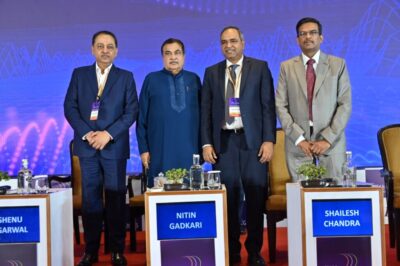
The Society of Indian Automobile Manufacturers (SIAM) convened its 65th Annual Convention at the Hotel Taj Palace, New Delhi, bringing together industry leaders, policymakers, and stakeholders to deliberate on the critical role of sustainable mobility in achieving Viksit Bharat by 2047.
The convention began with a welcome note and opening address by Mr. Shailesh Chandra, President, SIAM, and Managing Director, Tata Motors Passenger Vehicles Ltd. & Tata Passenger Electric Mobility Ltd. In his remarks, he highlighted the Indian automobile industry’s significant contribution to the economy, noting that the sector, valued at Rs. 20 lakh crore, contributes nearly 15% of India’s GST revenues, making it a true growth engine. He expressed appreciation to the Government for the landmark decision to reduce GST rates on vehicles, stating that this move would make automobiles more accessible, particularly for first-time buyers.
A special message from the Prime Minister of India, Narendra Modi, was also shared during the convention. The Prime Minister emphasized the need for self-reliance across the entire automotive manufacturing value chain and underlined that as the nation advances towards global leadership in green and smart transportation, the opportunities for investment and collaboration would be immense.
Government’s Vision for Sustainable Mobility
Delivering the Chief Guest Address, Nitin Gadkari, Union Minister of Road Transport & Highways, Government of India, outlined the government’s vision for sustainable transportation. He stressed that as the world’s third-largest automobile industry, India must focus on providing comfortable public transportation while maintaining global alignment on BS7 and CAFE norms to tackle air pollution challenges. He further emphasized the importance of shifting to biofuels, which would not only reduce India’s crude imports but also enhance farmer incomes. He announced that more than 3 lakh vehicles had been scrapped under the scrappage policy, benefiting the industry, government, and environment.
Addressing road safety, Gadkari admitted that fatalities remain a ‘dark area’ despite improvements in road infrastructure. He noted that while many defective roads have been upgraded, unsafe human behaviour remains the primary cause of accidents. He highlighted helmet usage as a major concern, revealing that 30,000 deaths occur annually due to riders not wearing helmets. He pointed to new regulations mandating two helmets with every two-wheeler purchase and stressed stricter enforcement of traffic laws.
The Minister described unsafe pedestrian crossings, lack of lane discipline, and use of mobile phones while driving as major behavioural problems, stating, “The bigger problem lies in how people behave on our roads.” He emphasized the need for public campaigns and NGO engagement to instill fear and respect for the law.
On fuel alternatives, Gadkari dismissed reports raising doubts about E20 and flex fuels as part of a “paid campaign” and clarified that both the Automotive Research Association of India (ARAI) and the Supreme Court had cleared the matter. He also announced that the government is working on introducing Bharat NCAP safety standards for e-rickshaws to improve passenger and pedestrian safety.
Highlighting the urgency of accident response, Gadkari revealed that 50,000 lives could be saved annually if victims received timely hospital care. To encourage bystanders, the government has introduced Good Samaritan protections, offering a reward of Rs. 25,000 for those who help accident victims and treatment coverage up to Rs. 1.5 lakh for at least seven days. He reiterated that reducing India’s logistics cost to single digits remains a top priority and concluded by stressing that road safety requires a multi-pronged approach—spanning infrastructure, enforcement, education, and behavioural change.
Support from Heavy Industries and Steel
Guest of Honour, H. D. Kumaraswamy, Union Minister of Heavy Industries and Steel, highlighted the government’s strong backing for the automobile industry. He noted that under the PLI scheme, companies have already invested more than Rs. 29,500 crore and assured continued collaboration with stakeholders to achieve sustainability goals. He also emphasized the steel industry’s efforts to develop specialized steel for the auto sector, aimed at reducing import dependence.
He underlined that India, now the fourth-largest economy and the fastest-growing major economy, produced over 34 million vehicles in FY 2024–25, positioning the auto sector as a key driver of growth.
Industry Leadership Perspectives
Mr. Shailesh Chandra reiterated that the Indian automotive industry is fully aligned with the government’s vision for sustainable, safe, and affordable mobility solutions. He expressed gratitude to the government for reducing GST on vehicles and initiating the Automotive Mission Plan, adding that the industry will work cohesively toward the shared goal of ‘Building the Nation, Responsibly’.
Mr. Shenu Agarwal, Vice President, SIAM and Managing Director & CEO, Ashok Leyland Ltd., also thanked the government for creating a conducive ecosystem that has enabled the auto industry to prosper.
Sustainable Mobility for Viksit Bharat
The convention featured an Inaugural Session on ‘Sustainable Mobility Paradigm for Viksit Bharat’, where speakers outlined India’s pathway to achieving sustainable, inclusive, and affordable mobility solutions by 2047. Discussions spanned EV adoption, clean fuels, resilient supply chains, and road safety initiatives, reinforcing the pivotal role of the automotive sector in shaping India’s growth story.




COMMENTS